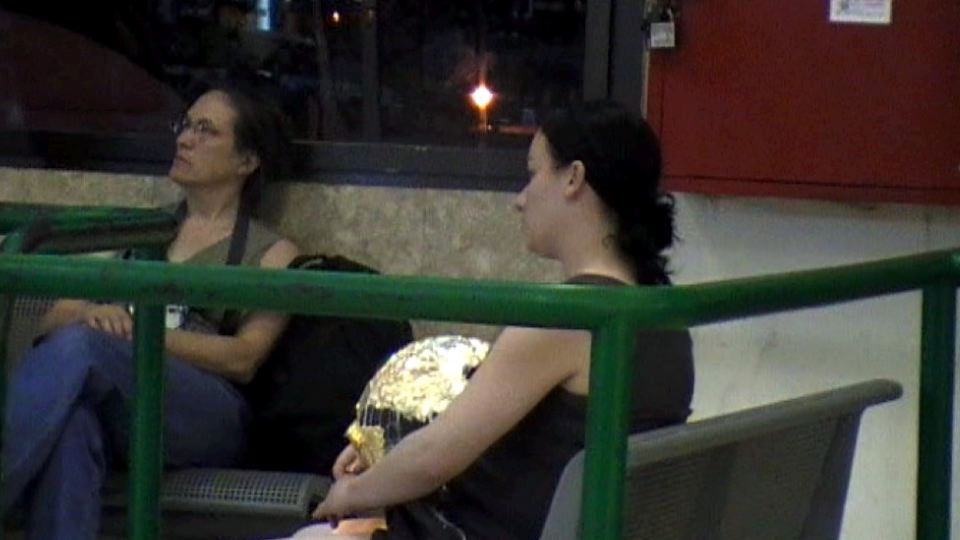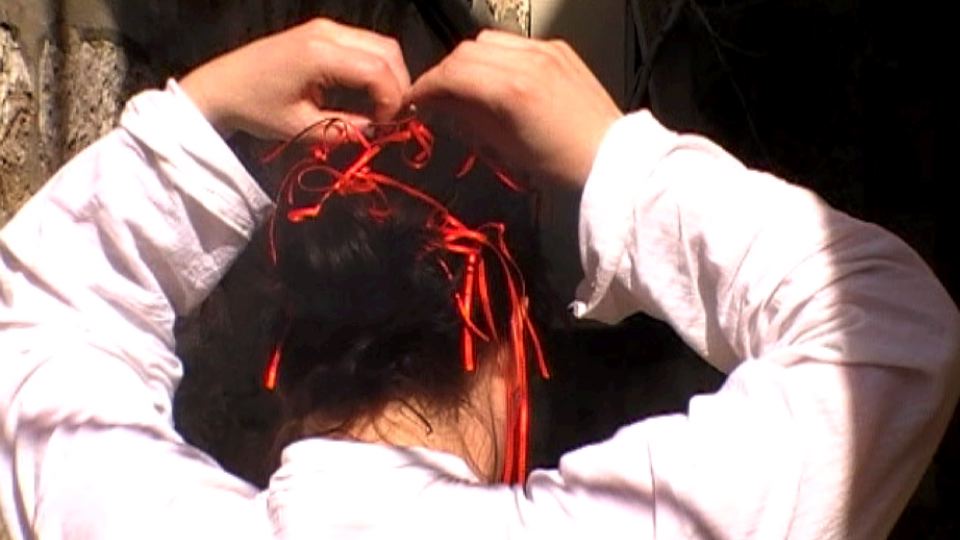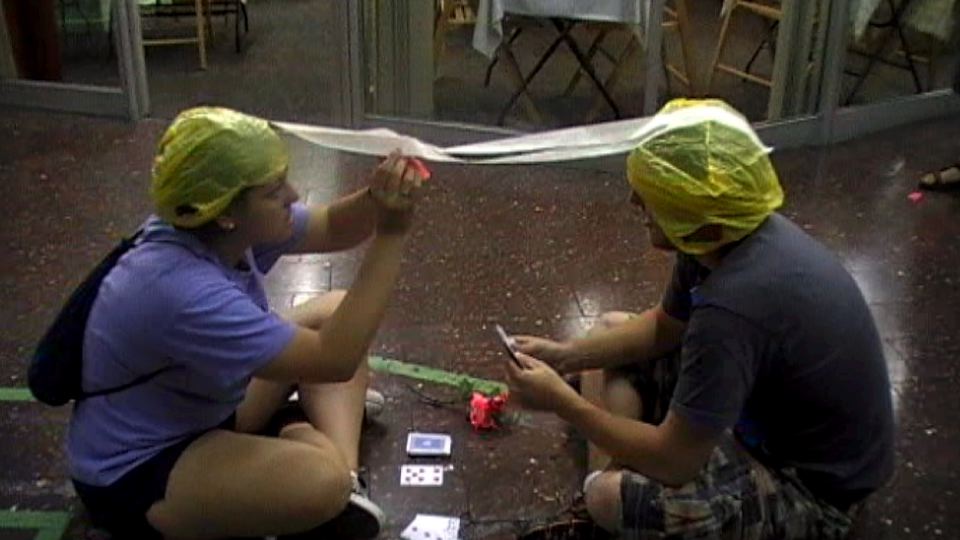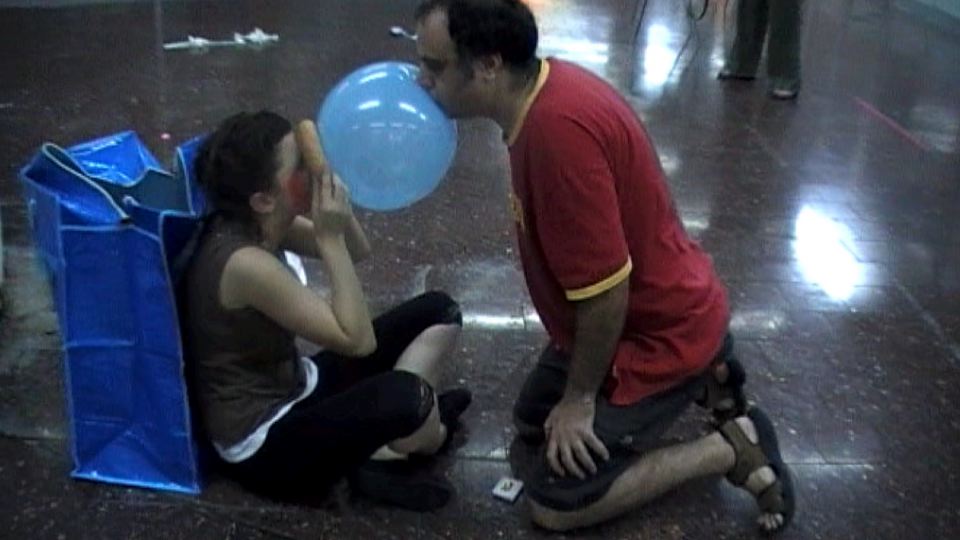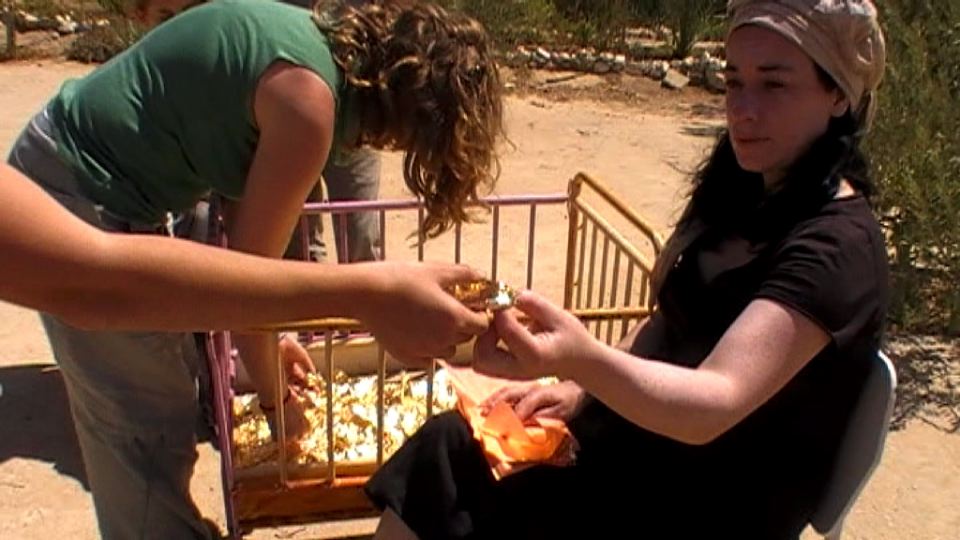Introductory remarks: I have followed Sinéad’s performance art practice for several years now, mostly from the distance facilitated by documentation. Last autumn she took part in festivals, projects and workshops in Israel, USA and Chile. I have chosen these performances for the following account of a ‘birth of an art work’.
SS: You have participated in the ZAZ festival in its twentieth year. Lasting eleven days, it moved from Tel Aviv to Jerusalem to Mizpeh Ramon at the edge of Negev desert.ZAZ has developed from an older tradition of performances and actions in Shelter 209 in Tel Aviv. The organizers say that ZAZ focuses on “peripheral action" both in terms of geography and in relation to mainstream art practices. While the emphasis on the old vocabulary makes me cringe, I admit that performance art is not the majority pursuit, both for visual artists and for audiences. ZAZ added an emphasis on artists’ immediate response to each site. How did you deal with the immediacy and responsiveness?
SO’D: My artwork has always investigated, and experimented with, ‘material’. This derives from my builder father, creative mother, from studying textiles, sculpture, and performance, and from a sort of obsession with what is valuable, and what is precious to me – and to others.
Going back to a question that you asked once about my transit or nomadic practice maybe having a negative impact in relation to cultural experiences: it is from these interventions, by making performance art, and through a thoughtful use of ‘material’, that I have been able to make a patchwork of the world and understand how it works. There is nothing more immediate than using the body.
I am interested in how we place value on ‘material’ and ‘object’. By paying close attention to the changes that occur to this, in different cultural contexts, by making actions – I am able to respond; the perceived value is what I use as a way to understand the personal, public, private and political.
Transitional events are close to me, to how I am. The spirit of them is something that I associate with shamanism, with the nature of performance as a tribal action. It is all around you, you are moving through time and the unpredictable. You learn how to trust the immediate, responsive and spontaneous nature of yourself. My work in Israel was entitled Material Memory, part of a series of performance research. I worked with gold leaf and red ribbons.
SS: Your use of gold leaf in Underbelly – any particular reason?
SO’D: This time last year, I sat in my mother’s kitchen drawing and I saw something gold and moving; it was a sensational feeling or experience, intuitive and imaginary, part of my personal process. Now I am sitting in the same kitchen at the same time of year, writing to Slavka about it, twelve months on. The images and visuals in my mind of something that needs to be gold, now, are getting stronger, becoming clearer with time.
SS: You used red ribbons in a performance in Ireland and now again in Israel. Is there a connection?
SO’D: In Co. Cavan as part of the Cavan Arts Festival, organised by Joe Keenan and curated by Bbeyond, after I arrived, I sat for an hour behind Brian Connolly’s market stall, and decided that I needed red ribbon (I had brought ribbons in mixed colours and textures). He had a roll in his bag and gave it to me. The red ribbons were for threading of my tied-back hair and contrasted with the large red balloon that I had stuffed up my black full-of-holes jumper. I intended it as a reference to pregnancy and the current state of the abortion laws in Ireland, the suppression of women, and an action that referenced the ages of gender silence and violence that we are still dealing with. I continued this in Israel.
SS: In the evening of 20 September you made your performance in the Central Bus Station in Tel Aviv. You wrote to me: “I will have an oversized baloon up my dress, I will sit and apply gold leaf onto the outside of the dress, so that the bump underneath turns gradually gold from the outside, just the stomach area… I will have a piece of paper from my notebook in my knickers, because I have my period, and during the time of the performance, I also bleed… no one will see this, for me it is a way of documenting what I am doing from the point of view of my body…" Later on you actually did it. Have you changed anything in response to that place?
SO’D: My intention was to push ‘material’ with ‘duration’ as action, that’s what I settled on before I left Belfast. My research focuses on the visual in performance to study the co-existence of other women; it has and does also involve men as an other, my gender-opposite. I amplify it and draw attention to this when I am in different geographical and social positions. Nothing is ever purely visual. Performance provokes that. It is how I communicate.
The first performance in these situations is always the most difficult, you sort of move through a doorway and then into the unknown. After Underbelly in the bus station, I was in it.
To speak about the occurrences, encounters and the effects of the place toward how I made my works in Israel: It is better for me to describe things to you from the inside of me, rather than only looking at the archived document or recording that I am left with. It takes a while. Maybe, there is another time for discussing the relics and museum of things…? It’s funny how we make graveyards out of everything, performance is a far more about being alive. So, I talk to you from memory.
SS: Go ahead.
SO’D: My work began with teaching a workshop in performance art. The participants were mainly American nationals in Israel, at that time, to study Judaism. They were not artists or students of art. I was also joined by some local students, so we were about twelve altogether. After receiving this information, I changed the approach of the workshop, from ‘Destruction versus Creation in performance’ to ‘Collective, collaborative co-operation’ (its alway a little easier to work as a group when you already belong to one). The workshop took place in the Shelter 209 space and the Central Bus Centre, Tel Aviv. I screened some documentation of collective situations that I had organised in Belfast and Transylvania. I then asked the students to take a trip to the dollar shop and purchase an item for 1 dollar. I asked them to keep in mind that they would be returning to collectively occupied public space – the bus centre – and making their own individual creative act. I waited for them and wondered if they would come back. Maybe I had freaked them out!? They came all back.
It is so strange at times, in Chile myself and Hugh O’Donnell taught workshops that dealt with the duo in action art. We divided the students into couples to work together for the duration of our work with them. A difficult task for some, they had never met before the workshops in Santiago. In Israel, quite a few of the students naturally began to work in twos. Interacting, maybe, because they were, as I said, already in a group relationship. I do think though that it was also, partly, because of a cultural tradition: theatre or dance work as a foundation for performance art in Israel. Our workshop crossed all borders of those disciplines. They rocked!.
SS: Having done the workshop you had time to perform your own work there. I have not perceived a continuity between the work you did with others and this performance. Yet, Underbelly, while intensely personal is very much about ‘the other’. You were alone, bar incidental audience, for hours in a public space. How has it worked for you?
SO’D: I sat on a metal seat on a bench, in the arrival and departure area of the Central Bus Centre, Tel Aviv. I worked for two and half hours. I repeatedly glued sheets of gold leaf to a dress under which I held a large balloon creating an illusion of pregnancy. Gold leaf is a gentle material, a slow material, a beautiful material. A little wind came in from the door of the departure gate, where I was sitting. I could only see the top of the balloon inside my dress, a grey lycra dress that I bought in a pound shop somewhere with a thought that I might use it in some work because it looked industrial. I was more or less gold-leafing my sculptural stomach blindly, I could not see how the leaf was going; I was getting used to its unpredictable nature.
I thought about how some people saw the performance and some saw the gold leaf. I wanted to make a monument, I wanted to make you, them, think more about this area of the stomach, about the superficial way that art and life can be. As I leafed my sculptural stomach, the baloon became not a baloon, but a place where I could put my past and my future, flipping back and forward from emotions to actionist decisions. Always threatening to burst. I did have a piece of paper in my knickers for the duration of this performance, using the trace of my menstrual cycle, as a way of measuring the time in my body. The seat was getting harder, the action was getting tougher, at one point there was a threshold in the action.The soldiers standing and watching me… they were as alien to me as I was to them. The glue I used was water-based and white, it looked like sperm running down the sides of my gold leafed belly, I could not see this until I saw the documentation. I then thought that the performance in a symbolic way without me ever considering it, had male or masculine value.
I reached for the top of one of the glue bottles, it was a little blunt, eventually it pierced the baloon, which crashed into my own stomach all wet and sticky. For me, it was beautiful to feel the shape of the gold leaf that was so monumental become flattened and pressed onto my body for the first time. Until then it existed in a distance from my body, apart from my hands. I worked for two and half hours. Then I stopped.
SS: So, you did in Tel Aviv what you planned in Belfast. Were there any substantial departures?
SO’D: Yes, there were substantial departures. I started to walk slowly backward along the streets of the Nachlaot community, Jerusalem. As I was doing this, I threaded cut red ribbons into my tied-back hair; the amount of ribbons determined the duration. I began to make this backward walking action in Serbia in 2007, then in Cavan, Ireland in 2008. Each performance was always in the direction of being backward, the actions changed according to how I felt about the place and sometimes whatever I had in my pockets or suitcase. Backward project is about two things, one: to give or slow down time, to take in things, to look, to watch, to trust, to feel balance coming, get back into your body; and two: it’s a way of dealing with being dyslexic in a physical way. As a sideline these days, I am researching what is disability in performance art. A question of site was the departure, the market or the street. To be in the market, it was my feeling, that my actions had to be loud because the space was always jam-packed. I wasn’t interested in the dynamics of the market. Usually I am, but after the bus centre in Tel Aviv, I needed some time to reflect, a wee bit of calm. I chose the streets of the local area, quiet, not so many people moving around. The feeling that people were around on the inside of walls of little houses was what attracted me. I found it difficult to get my head around the territory; where do the religion and tradition meet the street? In some parts women could not be there unless they were fully covered; the streets were not marked, I did not understand the writing on the notices. Living in Northern Ireland for so long conditioned my experiencing these streets; it was not until this experience that I realized how much I mapped daily life through visuals of political territory. It was also something that I had to learn very quickly when I moved to Belfast from Dublin in 1995. In Jerusalem, the Bostonian performance artist Marilyn Arsem defined the borders for me. Dressed like a Bedouin, she pushed a wheelbarrow, with a hole in the bottom of it, filled to the brim with soil, through the streets; she left a trail. And as I was walking backwards, threading cut red ribbons into my tied-back hair, I could look down and see the mark of her line where she had been before me. I worked for two hours. Then I stopped.
SS. At this point our email exchange has transformed into Sinead’s monologue about work she performed in the desert.
SO’D: This was a burst, a burst to get out of my headspace, away from Jerusalem. The light and dark changed so fast in the sky it was like, it was an on/ off switch, so I needed lights at night. Later that evening I looked for something, not really sure what, a place, where the energy was for me, and I saw this sink, an outdoor sink, surrounded by what looked like a place for tending plant life. It is always about finding where the inside meets the outside. Backward action was re-thought by using the running water tap and putting my head underneath it, and red ribboning my tied-back hair while my head was under the water. I worked for an hour. It was cold. It was another way of defining territory and what my identity was within that. Then I stopped.
Tamar Raban (the organizer of the ZAZ festival) asked me if I had found an action. I went for a wander, back to the place where the sink was. After a while, I found a baby’s cot in a bush. Pulled it out, examined it briefly, and found a connection to the Underbelly action, a week or so ago in the bus centre in Tel Aviv. I sat on a plastic chair beside an olive tree, and using glue began to gold-leaf the base of the baby’s cot only. I was amazed at how the gold-leaf almost danced on my fingers with the desert wind, and as a material it didn’t struggle so much as it did in Underbelly. One or two leaves flew away from my hands and went through the wind, and didn’t break. I liked the experience of watching it move through the air. The audience watched too, or just passed by, stood close, or moved back. I decided that they would only understand the significance of the material and understand the action if I allowed them in, inside the performance. As they watched and stood beside me, I passed them pieces of the gold leaf and invited them to make my action, place the gold leaf onto the base of the cot, eventually covering it. The cot was as empty as the balloon that was under my dress in Underbelly. I worked for three hours.
One woman prayed as she was doing it, another came back and forward, she sort of hovered for the duration, another woman said that she finds it hard to make a performance, and she only makes one a year, and asked if that was a sign of being a bad artist. I said I needed to drink some water…I asked her, would you sit on my seat, please, and continue to make my action by gold-leafing the base of this cot while I go to drink some water…she did…and then I got the water from inside and sat for about ten minutes away from her, out of sight, and drank my water watching her making my action; I went back then and freed her…then I stopped.
STOP THE WAR.
SS: Sinead O’Donnell is dyslexic, so writing this was an ordeal for her. Yet, never once did she complain or did she give up. The opposite happened: I have a huge file of her long e-mails sent from the sites of her actions. They are less tidy than what you just read, but they were equally filled with her dedication to people and art. Her integrity rules out any trace of pretence . She nourishes her spontaneity by courage and her value judgements by taking risks.
As an afterthought: a newspaper story I read when visiting Israel during one peaceful period of high hope, wrestles now back into my attention. There were reports, also on TV, of many Israeli women having a higher number of children, so as to compensate for all the children murdered in concentration camps during WW2, during the Holocaust. Two of Sinead’s works relate directly to pregancy (Underbelly) and childcare (The Cot). The middle one, the red ribbons, does too, being reminiscent of the ancient tradition of ‘segulah’, a scarlet thread, first wound around the tomb of the biblical Rachel (Genesis: 35,19-20), and then worn by pregnant women for protection. Given that Sinead trusts her intuition and spontaneity, such a connection is not contrary to the planned parts of her performance.
Slavka Sverakova writes on art.
